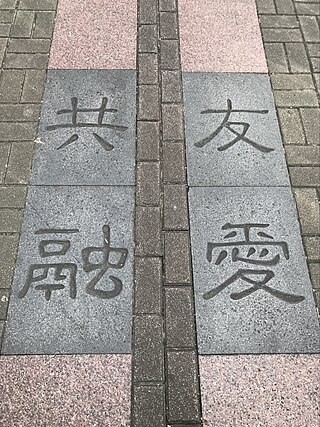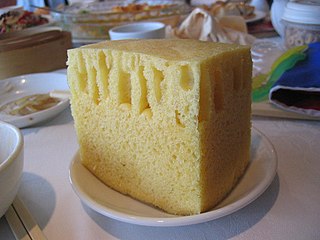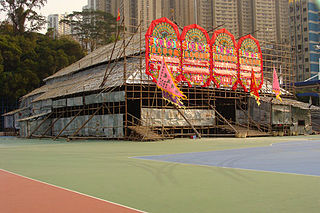
Teochew cuisine,also known as Chiuchow cuisine,Chaozhou cuisine or Teo-swa cuisine,originated from the Chaoshan region in the eastern part of China's Guangdong Province,which includes the cities of Chaozhou,Shantou and Jieyang. Teochew cuisine bears more similarities to that of Fujian cuisine,particularly Southern Min cuisine,due to the similarity of Teochew's and Fujian's culture,language,and their geographic proximity to each other. However,Teochew cuisine is also influenced by Cantonese cuisine in its style and technique.

Chaozhou,alternatively Chiuchow,Chaochow or Teochew,is a city in the eastern Guangdong province of China. It borders Shantou to the south,Jieyang to the southwest,Meizhou to the northwest,the province of Fujian to the east,and the South China Sea to the southeast. It is administered as a prefecture-level city with a jurisdiction area of 3,110 km2 (1,200 sq mi) and a total population of 2,568,387. Its built-up area encompassing most of Shantou and Jieyang cities was home to 12,543,024 inhabitants on 13 local administrative areas. Along with Shantou and Jieyang,Chaozhou is a cultural center of the Chaoshan region.

Music of Malaysia is the generic term for music that has been created in various genres in Malaysia. A great variety of genres in Malaysian music reflects the specific cultural groups within multiethnic Malaysian society:Malay,Indonesian,Arabic,Chinese,Indian,Dayak,Kadazan-Dusun,Bajau,Orang Asli,Melanau,Kristang and others.

Traditional Chinese opera,or Xiqu,is a form of musical theatre in China with roots going back to the early periods in China. It is an amalgamation of various art forms that existed in ancient China,and evolved gradually over more than a thousand years,reaching its mature form in the 13th century,during the Song dynasty. Early forms of Chinese theater are simple;however,over time,various art forms such as music,song and dance,martial arts,acrobatics,costume and make-up art,as well as literary art forms were incorporated to form traditional Chinese opera. Performers had to practice for many years to gain an understanding of the roles. Exaggerated features and colors made it easier for the audience to identify the roles portrayed.

The culture of Hong Kong is primarily a mix of Chinese and Western influences,stemming from Lingnan Cantonese roots and later fusing with British culture due to British colonialism. As an international financial center dubbed "Asia's World City",contemporary Hong Kong has also absorbed many international influences from around the world. Moreover,Hong Kong also has indigenous people and ethnic minorities from South and Southeast Asia,whose cultures all play integral parts in modern-day Hong Kong culture. As a result,after the 1997 transfer of sovereignty to the People's Republic of China,Hong Kong has continued to develop a unique identity under the rubric of One Country,Two Systems.

Cantonese opera is one of the major categories in Chinese opera,originating in southern China's Guangdong Province. It is popular in Guangdong,Guangxi,Hong Kong,Macau and among Chinese communities in Southeast Asia. Like all versions of Chinese opera,it is a traditional Chinese art form,involving music,singing,martial arts,acrobatics,and acting.

Chinese Singaporeans are Singaporeans of Han Chinese ancestry. Chinese Singaporeans constitute 75.9% of the Singaporean resident population according to the official census,making them the largest ethnic group in Singapore.

Chaoshan or Teoswa is a cultural-linguistic region in the east of Guangdong,China. It is the origin of the Min Nan Chaoshan dialect (潮汕话). The region,also known as Chiushan in Cantonese,consists of the cities Chaozhou,Jieyang and Shantou. It differs linguistically from the rest of Guangdong province,which was historically dominated by Yue speakers,Hakka,and Leizhou Min speakers. However,Mandarin has recently become the dominant language in the region. It is historically important as the ancestral homeland of many citizens of other countries of Chinese descent,including Viets,Thais,Cambodians,Singaporeans,Malaysians,and Indonesians.

The Hoklo people are a Han Chinese subgroup who speak Hokkien,a Southern Min language,or trace their ancestry to southeastern Fujian in China,and known by various related terms such as Banlam people,Minnan people,or more commonly in Southeast Asia as the Hokkien people. The Hokkien people are found in significant numbers in mainland China,Taiwan,Hong Kong,Macau,Singapore,Malaysia,Philippines,Indonesia,Brunei,Myanmar,and the United States. The Hokkien people have a distinct culture and architecture,including Hokkien shrines and temples with tilted sharp eaves,high and slanted top roofs,and finely detailed decorative inlays of wood and porcelain. The Hokkien language,which includes Taiwanese Hokkien,is the mainstream Southern Min,which is partially mutually intelligible to the Teochew language,Hainanese,Leizhou Min,and Haklau Min.
The Han Chinese people can be defined into subgroups based on linguistic,cultural,ethnic,genetic,and regional features. The terminology used in Mandarin to describe the groups is:"minxi",used in mainland China or "zuqun",used in Taiwan. No Han subgroup is recognized as one of People's Republic of China's 56 official ethnic groups,in Taiwan only three subgroups,Hoklo,Hakka and Waishengren are recognized.

Buchaechum is a Korea fan dance originating from various traditional and religious Korean dances. It is usually performed by groups of female dancers.

Huangmei Opera or Huangmei tone is a form of Chinese opera originating from Anqing,Anhui province,as a form of rural folk song and dance. It is also referred to as Anhui Opera. It has been in existence for the last 200 years and possibly longer. Huangmei opera is one of the most famous and mainstream opera in China,and is a class of the typical Anhui opera. The original Huangmei opera was sung by women in Anqing areas when they were picking tea,and the opera was called the Picking Tea Song. In the late Qing dynasty,the songs were popular in Anhui Huaining County adjacent regions,combined with the local folk art,Anqing dialect with singing and chants,and gradually developed into a newborn's operas. The music is performed with a pitch that hits high and stays high for the duration of the song. It is unique in the sense that it does not sound like the typical rhythmic Chinese opera. In the 1960s Hong Kong counted the style as much as an opera as it was a music genre. Today it is more of a traditional performance art with efforts of revival in mainland China,Hong Kong,and Taiwan,and mostly sung in Mandarin. In 2006,Huangmei Opera was selected for the first batch of China's national intangible cultural heritage.
The Teochew people or Chaoshanese,Teo-Swa people or Chaoshan people is an ethnic group native to the historical Chaoshan region in south China who speak the Teochew language. Today,most ethnic Teochew people live throughout Chaoshan and Hong Kong,and also outside China in Southeast Asia,including in Singapore,Malaysia,Thailand,Indonesia,Cambodia,Vietnam,and the Philippines. The community can also be found in diasporas around the world,including the United States,Canada,Australia,New Zealand,and France.

Malaysian folk religion refers to the animistic and polytheistic beliefs and practices that are still held by many in the Islamic-majority country of Malaysia. Folk religion in Malaysia is practised either openly or covertly depending on the type of rituals performed.
Teochew Poit Ip Huay Kuan is a Teochew clan association in Singapore. Poit Ip,which means eight districts in the Teochew dialect,stood for the eight Teochew districts in the province of Guangdong,China. Huay Kuan means "clan association". On 12 December 1928,there was a temporary committee convened a meeting at the Tuan Mong School in preparation of the formation of the Huay Kuan. On 20 March 1929,British colonial authorities exempted the Teochew Poit Ip Huay Kuan from registration,and it was formally established.

Jiexi County is a county of eastern Guangdong province,China. It is under the administration of Jieyang City.
Chuanqi is a form of Chinese opera popular in the Ming dynasty (1368–1644) and early Qing dynasty (1644–1912). It emerged in the mid-Ming dynasty from the older form of nanxi. As it spread throughout the empire,it absorbed regional music styles and topolects and eventually evolved into different local genres,among them kunqu. Of the 2000 plus titles recorded in history,over 600 chuanqi plays are extant and are still performed today,including The Peony Pavilion by Tang Xianzu,The Palace of Eternal Life by Hong Sheng,and The Peach Blossom Fan by Kong Shangren.
Teochew Letters were a form of family correspondence combined with remittance,sent by Teochew immigrants in Southeast Asia as well as Hong Kong,to their families in the Teochew region,in eastern Guangdong Province,China.

Malay sponge cake is a popular dessert cake in Guangdong and in Hong Kong. It usually can be seen at a traditional teahouse in Guangdong and Hong Kong. The cake is made of lard or butter,flour,and eggs,using a bamboo steamer to develop puffiness. An entire Malay sponge cake is a huge yellow round cake,but is generally sold as slices in teahouses. In Hong Kong,where it is very popular,the cake was listed as the "national cake" by the American news channel CNN.

Opera with divine powers (酬神戲) is a form of Chinese opera played at religious ceremonies,including for the gods' birthday,temple opening,at miaohui,ghost festival,Daijiao,and traditional festivals. It is the play performed to welcome the gods' race and is one of a series of celebrations held by the people to thank the gods and reward them for their blessings. Usually performed at temple fairs or theatres. In Guangdong,it is mostly called Shen Gong Xi(神功戲),and in China,in the north,it is mostly called She Xi社戏(the word "She" in the word "She Xi" refers to the place where the Sheshen was worshiped in the old days,and there is another saying that the word "She" was a small unit in the ancient region,and the drama was performed in the She,which was called She drama)。On birthdays,where this form of opera is played,are those of the gods:Xuanwu,Guan Yu,Dragon King,Mazu,Shanshen,City God,and Tudigong.















